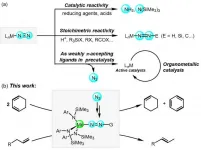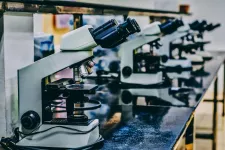Study the boundary between bulk, nano and molecule scale of gold plasmonic physics
2021-01-14
(Press-News.org) As an elementary type of collective excitation, plasmon has been found to dominate the optical properties of metals. The collective behavior of electrons in plasmons reflects the important difference between condensed matter and molecule-like ones. It is of great significance to study the evolution of plasmonic response and find out the boundary.
Controversy exists on such interesting questions as the division between the nanoparticle and molecules, and the physics of mesoscopic and microscopic plasmonic evolution. A unified understanding covering the small and large size limit, namely macro / meso / micro scales with sufficiently atomic precision is thus required. Clusters, as the transition from atomic molecules to condensed matter, are the ideal candidate for studying the evolution of plasmons.
In a new overview published in the Beijing-based National Science Review, A joint team from Nanjing University, Southern University of Science and Technology, National University of Defense Technology, Institute of Physics, Chinese Academy of Sciences and National Center for Nanoscience and Technology present a research on the evolution of plasmon through mass-selected gold clusters. In this work, scientists push the limit to atomic scale and present a complete evolution picture of size-dependent plasmon physics.
Gold clusters with precise atomic number ranging from 70000 to 100 were prepared using time-of-flight mass-selected magnetron sputtering gas-phase condensation cluster beam source in Fengqi Song's group. The mass resolution M / Δ M was about 50. Scientists then successfully measured the plasmonic responses of a series of atomically precise individual gold particles with atom number (N) of 100-70000 through the well collected high-resolution electron energy loss spectroscopy with the great help of Jiaqing He's group and Pico Center at SUSTech.
Scientists found three characteristic regimes separated by the two grey bold vertical dashed lines, as shown below. In regime 3 (N~887-70000), the positions of the peak of surface plasmon (SP) exhibit a very slight red shift with decreasing N, while the peak of bulk plasmon (BP) remains unchanged and the full width at half maximum (FWHM) remains at a high value of about 0.36 eV. In regime 2 (N~300-887), the position of the peak of SP exhibits a steady blueshift with decreasing N, while the peak of BP disappears completely and the FWHM stays at a high value of about 0.26 eV. In regime 1 (N~100-300), the peak of SP is replaced by 3 fine features with a much smaller FWHM, which is close to the FWHM of the EELS zero-loss peak.
Based on the basic physical model, the physics of the three regimes is explained below. For large clusters with similar electronic structures like bulk, the redshift of SP in regime 3 is explained by electron-boundary scattering modified classical plasmon (Nanoscale. 2017; 9: 3188-95). The reduction in the size only introduces extra boundary scattering for free electrons in the metal, in addition to the Coulomb scattering between electrons. The classical model calculations performed by Jianing Chen's group show good agreement with the experimental results. With the continuous decrease of cluster size, the monotonic blueshift of SP in regime 2 is caused by the well-studied quantum confinement effects (Nature. 2012; 483: 421-7; Nat Phys. 2019; 15: 275-80). The classical Drude model for the dielectric function becomes invalid and gives its way to the quantum-descripted one. Here the total permittivity ε is the sum of the permittivity of free electron transitions in the quantized conduction band and the frequency-dependent permittivity εinter of interband transitions between the d bands and the higher conduction bands. When the bulk-like electronic structure is finally destroyed with even fewer atom numbers in clusters (Nat Commun. 2016; 7: 13240; J Am Chem Soc. 2018; 140: 5691-5), superimposed transitions between quantized molecule-like electronic structures happens, and the traditional plasmonic peak degenerated into fine structures (molecular plasmon, regime 1). With the help of Jiayu Dai's group, the rt-TDDFT calculations show that after strong laser action, the collective charge density oscillation could be found at the core of the cluster, which is quite different from the case for a weak laser field. The collective behavior of electrons is some superimposition of single electron transitions between quantized molecular energy levels (Nat Commun. 2015; 6: 10107). Thus 3 regimes in the plasmonic evolution are observed with distinct physics, namely classical plasmon (N=887-70000), quantum confinement corrected plasmon (N=300-887) and molecule related plasmon (N END
ELSE PRESS RELEASES FROM THIS DATE:
Temperature scanners of limited value in detecting Covid-19
2021-01-14
Making people stand in front of a scanner to have their body temperature read can result in a large number of false negatives, allowing people with Covid-19 to pass through airports and hospitals undetected.
A new study argues that taking temperature readings of a person's fingertip and eye would give a significantly better and more reliable reading and help identify those with fever.
The study, co-led by human physiologist and an expert in temperature regulation, Professor Mike Tipton, is published in Experimental Physiology.
Professor Tipton, ...
Catalyticity of molybdenum-dinitrogen complexes in organic reactions
2021-01-14
Dinitrogen (N2) fixation is considered as one of the most essential tasks in basic science, providing straightforward methods to produce ammonia and nitrogen-containing molecules. Exploring the reactivity of N2 units of transition metal-nitrogen complexes is of great significance and challenging in the chemistry. Since the first Ru-N2 complex was prepared in 1965, important progress has been made in the synthesis and reactivity of transition metal nitrogen complexes. In many cases, terminal end-on M-N2 complexes as the most prevalent bonding mode were proved ...
Spectacular fossil discovery:
2021-01-14
In a new study, an international research team led by Sebastian Stumpf from the University of Vienna describes an exceptionally well-preserved skeleton of the ancient shark Asteracanthus. This extremely rare fossil find comes from the famous Solnhofen limestones in Bavaria, which was formed in a tropical-subtropical lagoon landscape during the Late Jurassic, about 150 million years ago. The almost complete skeleton shows that Asteracanthus was two-and-a-half meters long in life, which makes this ancient shark one of the largest of its time. The study is published in the journal Papers in Palaeontology.
Cartilaginous fishes, which include sharks and rays, are one of the most successful vertebrate groups still ...
Micro-climate moulds and reshapes northern insect communities, herbivory and predation
2021-01-14
Climate and changes in it have direct impacts on species of plant and animals - but climate may also shape more complex biological systems like food webs. Now a research group from the University of Helsinki has investigated how micro-climate shapes each level of the ecosystem, from species' abundances in predator communities to parasitism rates in key herbivores, and ultimately to damage suffered by plants. The results reveal how climate change may drastically reshape northern ecosystems.
Understanding the impact of climatic conditions on species interactions is imperative, as these interactions include such potent ecological forces as herbivory, pollination and parasitism.
Lead researcher Tuomas Kankaanpaa from the Faculty of Agriculture and Forestry, University of Helsinki, investigated ...
Giant map of the sky sets stage for ambitious DESI survey
2021-01-14
Astronomers using images from Kitt Peak National Observatory and Cerro Tololo Inter-American Observatory have created the largest ever map of the sky, comprising over a billion galaxies. The ninth and final data release from the ambitious DESI Legacy Imaging Surveys sets the stage for a ground-breaking 5-year survey with the Dark Energy Spectroscopic Instrument (DESI), which aims to provide new insights into the nature of dark energy. The map was released today at the January 2021 meeting of the American Astronomical Society.
For millennia humans have used maps to understand and navigate our world and put ourselves in context: we rely on maps to show us where we are, where we came from, and where we're going. Astronomical maps continue this tradition on a vast scale. They ...
Penned release of green geckos has potential to help preserve threatened native species
2021-01-14
University of Otago researchers have added another piece to the puzzle about how best to translocate New Zealand lizards for conservation purposes - confine them.
In a paper just published in the New Zealand Journal of Ecology, the Department of Zoology researchers outlined how they translocated 19 barking geckos to Mana Island, using the method of penned release - enclosing them in a 100m² pen for three months so they get used to the site and hopefully establish a breeding population.
It was the first time such a method had been used with the species and the researchers found it worked well. The geckos' area use decreased over time, indicating ...
Researchers identify promising model for studying human aging
2021-01-14
There are many components to aging, both mental and physical. When it comes to the infrastructure of the human body - the musculoskeletal system that includes muscles, bones, tendons and cartilage - age-associated decline is inevitable, and the rate of that decline increases the older we get. The loss of muscle function -- and often muscle mass -- is scientifically known as sarcopenia or dynapenia.
For adults in their 40s, sarcopenia is hardly noticeable -- about 3% muscle mass is lost each decade. For those aged 65 years and older, however, muscle decline can become much more rapid, with an average loss of 1% muscle mass each year. More importantly, sarcopenia is also marked by a decrease ...
Eastern and central China become brighter due to clean air action
2021-01-14
Since 2013, China has implemented the strictest ever air pollution control policies, which resulted in substantial reductions in aerosol concentrations.
However, extreme and persistent haze events frequently occur during wintertime in China. In winter haze events, aerosol-related reductions of surface solar radiation (SSR) have comparable impacts on clouds over eastern provinces.
Recently, researchers from the Institute of Atmospheric Physics (IAP) of the Chinese Academy of Sciences and the Pacific Northwest National Laboratory of the United States (PNNL) and their collaborators conducted a study to further understand the underlying chemical mechanisms driving winter haze events and how ...
Scientists are a step closer to developing 'smart' stem cells - made from human fat
2021-01-14
A new type of stem cell - that is, a cell with regenerative abilities - could be closer on the horizon, a new study led by UNSW Sydney shows.
The stem cells (called induced multipotent stem cells, or iMS) can be made from easily accessible human cells - in this case, fat - and reprogrammed to act as stem cells.
The results of the animal study, which created human stem cells and tested their effectiveness in mice, was published online in Science Advances today - and while the results are encouraging, more research and tests are needed before any potential translation ...
Males of all ages more affected by COVID-19 than females, study finds
2021-01-14
Males are more likely to test positive for COVID-19, more likely to have complications and more likely to die from the virus than females, independent of age, according to a new study published this week in the open-access journal PLOS ONE by Farhaan Vahidy of Houston Methodist Research Institute, US, and colleagues.
As the COVID-19 pandemic unfolds and evolves across the globe, researchers have identified population sub-groups with higher levels of disease vulnerability, such as those with advanced age or certain pre-existing conditions. Small studies from China and Europe have indicated that males tend to experience higher disease ...




